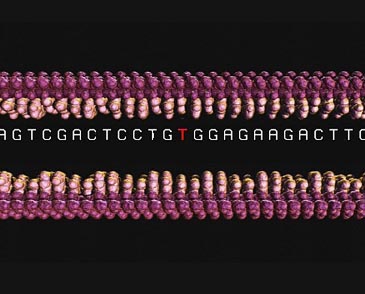DNA mutation

Multiple mutations at the same position in a DNA sequence can confound calculations of evolutionary time.
dna mutation,dna sequence,evolutionary time,mutations
- ID: 15609
- Source: DNALC.DNAi
Related Content
15979. A mitochondrial DNA sequence
Human mitochondrial DNA is 16,569 base pairs in length.
15980. Accumulating mutations
Mutations are the grist of evolution, and have accumulated in our DNA over time. When populations separate, each group accumulates their own unique set of DNA mutations.
15978. Mitochondrial DNA: a closer look
DNA found in the mitochondrion of a cell differs in structure and is separate from the DNA found in the cell nucleus. Mitochondrial DNA, or mtDNA, exists as a circular loop of double-stranded DNA rather than the linear form found in nuclear DNA. However,
15977. Maternal inheritance
Unlike nuclear DNA, mtDNA is  inherited solely from the mother. (Mitochondria are predominantly from the motherâs egg and not from the fatherâs sperm.) Therefore, mtDNA sequences or orders of nucleotides generally remain constant over many generation
15881. Defining the gene
Seymour Benzer was able to map mutations within one phage gene and correlate the mutations with protein changes. This showed that the DNA sequence of a gene was aligned with protein sequence.
15168. Accumulating DNA mutations through time, Mark Stoneking
Geneticist Mark Stoneking talks about the difficulties of measuring time by mutations.
15529. Radiation can cause DNA mutations, 3D animation with narration
Mutations and the molecular clock.
15178. Mitochondrial DNA and the molecular clock, Douglas Wallace
Geneticist Douglas Wallace explains a method of mapping a population's history using the mutations accumulated by its members.
15092. Studying the Y chromosome to understand population origins and migration, Michael Hammer
Evolutionary geneticist Michael Hammer speaks about the markers used to analyze DNA variation in the Y chromosome.
15608. Human/Neandertal/Chimp mutation evoluton tree
Mutations in our DNA can be used to trace the relationships between different populations and species.












